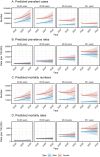Trends in prevalence, mortality, and risk factors of dementia among the oldest-old adults in the United States: the role of the obesity epidemic
- PMID: 38696055
- PMCID: PMC11336039
- DOI: 10.1007/s11357-024-01180-6
Trends in prevalence, mortality, and risk factors of dementia among the oldest-old adults in the United States: the role of the obesity epidemic
Abstract
The oldest-old population, those aged ≥ 80 years, is the fastest-growing group in the United States (US), grappling with an increasingly heavy burden of dementia. We aimed to dissect the trends in dementia prevalence, mortality, and risk factors, and predict future levels among this demographic. Leveraging data from the Global Burden of Disease Study 2019, we examined the trends in dementia prevalence, mortality, and risk factors (with a particular focus on body mass index, BMI) for US oldest-old adults. Through decomposition analysis, we identified key population-level contributors to these trends. Predictive modeling was employed to estimate future prevalence and mortality levels over the next decade. Between 1990 and 2019, the number of dementia cases and deaths among the oldest-old in the US increased by approximately 1.37 million and 60,000 respectively. The population growth and aging were highlighted as the primary drivers of this increase. High BMI emerged as a growing risk factor. Females showed a disproportionately higher dementia burden, characterized by a unique risk factor profile, including BMI. Predictions for 2030 anticipate nearly 4 million dementia cases and 160,000 related deaths, with a marked increase in prevalence and mortality anticipated among those aged 80-89. The past 30 years have witnessed a notable rise in both the prevalence and mortality of dementia among the oldest-old in the US, accompanied by a significant shift in risk factors, with obesity taking a forefront position. Targeted age and sex-specific public health strategies that address obesity control are needed to mitigate the dementia burden effectively.
Keywords: Body mass index; Dementia; Mortality; Prevalence; Public health.
© 2024. The Author(s), under exclusive licence to American Aging Association.
Conflict of interest statement
The authors declare no competing interests.
Figures




References
-
- Alzheimer's Association. Alzheimer’s disease facts and figures. Alzheimers Dement. 2019;15:321–387.
-
- Xu J, Zhang Y, Qiu C, Cheng F. Global and regional economic costs of dementia: a systematic review. The Lancet. 2017;390:S47.10.1016/S0140-6736(17)33185-9 - DOI
-
- Wu Q, Gu D. Oldest-Old Adults. In: Gu D, Dupre ME, editors. Encyclopedia of gerontology and population aging. Cham: Springer International Publishing; 2021. p. 3637–53.
MeSH terms
Grants and funding
LinkOut - more resources
Full Text Sources
Medical
Miscellaneous

